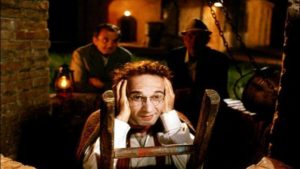STUDIO: Arrow Video/MVD | DIRECTOR: Federico Fellini | CAST: Robert Benigni, Paulo Villagio, Nadia Ottaviani, Marisa Tomasi, Angelo Orlando
RELEASE DATE: 10/31/17 | PRICE: Blu-ray/DVD Combo $25.19
BONUSES: Documentary “Towards the Moon with Fellini,” gallery of posters and photos, booklet with essays
SPECS: NR | 121 min. | Foreign language drama | Anamorphic widescreen | stereo | Italian with English subtitles
At long last, American cinephiles can see the The Voice of the Moon, the final film of Federico Fellini, an episodic meditation on art, love, sex and, of course, death. The 1990 film is uneven, but the scenes that work are absolutely gorgeous and remind us that, while there were several Fellini imitators working in Europe (and America) in the second half of the 20th century, there was only one Fellini, capable of overwhelming us with beauty (and perversity) as his films took our breath away.
It was never clear why American audiences didn’t get to see Voice of the Moon in regular theatrical distribution. Whatever the reason, it debuted as part of a touring festival called “Tutto Fellini” back in 1993 and has since been included in some U.S. retrospectives. Thus, this Arrow package (which includes both Blu-ray and DVD versions and, in the first pressing, a booklet with new essays) marks its mainstream U.S. debut and is essential for fans of Il Gran Maestro of poignant and grotesque imagery.
By 1990 Fellini had already made what could be considered two “farewell” films, the moving nostalgic drama Ginger and Fred (1986), starring his two most emblematic performers (Marcello Mastroianni and Gelsomina herself, Fellini’s wife Giulietta Masina), and Intervista (1987), in which he revisited Cinecitta and depicted his younger years in a semi-fictional form.
With Voice of the Moon, he chose to craft a dream film that includes the issues many a senior (and middle-aged person) dotes on, but in a whimsical, fantastic context — unlike his “old master” colleagues (and friends) Bergman and Kurosawa who made serious “senior dramas” at the end with Saraband and Maadadayo.
Here a poet, played by Roberto Benigni (To Rome With Love), journeys through various situations, smitten (as were many of Fellini’s lead characters) with an impossibly “perfect” object of obsession. Along the way we see other characters’ stories, ranging from the travails of a bureaucrat (Paulo Villagio) who has been laid off because of his age to a small man who is overpowered sexually by his zaftig wife (yes, Fellini remained consistent to the end).
One need not worry about following the plot here, as the landscape Benigni moves through is a transparently allegorical one that includes cemeteries and a ladder that leads up to the stars. The best sequences linger in the memory long after the film is over — for example, a scene at a dance club in which the younger dancers make way for an older couple who waltz to “The Blue Danube.” When the number is finished, the couple is swept up in the teeming crowd of young people. They had their moment and it was sublime, but things have to move on….
The script by Fellini, Ermanno Cavazzoni and Tullio Pinelli is about the expectation of, and curiosity about, death, as when Benigni’s character asks, “Where does the fire go when it goes out? It’s just like music. Nobody knows where it goes when it ends.”
The package contains only two visual supplements but they are both quite good. The first is a selection of stills, lobby cards and posters for the film, collected by a Fellini fan in Fort Worth, Texas.
The second is an hour-long, making-of documentary that has a coy frame device in which an “American” reporter (Christina Engelhardt) wanders around the film set. The doc offers a last look at Fellini in full bloom, meticulously attending to both large and small details (there was no indication that this will be his last picture).
The “reporter” has a hard time finding out what the film is about, but in the meantime we hear from the crew, the colorful extras and stars Benigni and Villagio. We also see a familiar face in the crowd during the dance club scene — Jim Jarmusch, who was, presumably, invited to the set by Benigni (their Down by Law was made a few years earlier).
The most interesting moments in the doc depict Fellini’s approach to direction. The first is that he didn’t create storyboards, but instead drew single-panel illustrations of the characters and some situations and presented those to the crew to illustrate what he wanted to do in given scenes.
The other is an element that linked his work to silent cinema. He would speak through a megaphone to the actors, as his films were post-synced under his supervision after the shooting was finished. These glimpses of Fellini making movies like the silent masters reinforce his status as one of most singular and imaginative visionaries in world cinema.
|
Buy or Rent The Voice of the Moon
|
|---|

Leave a Reply